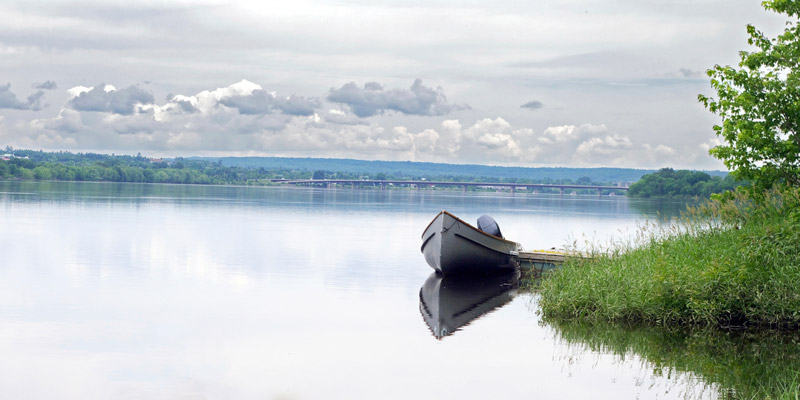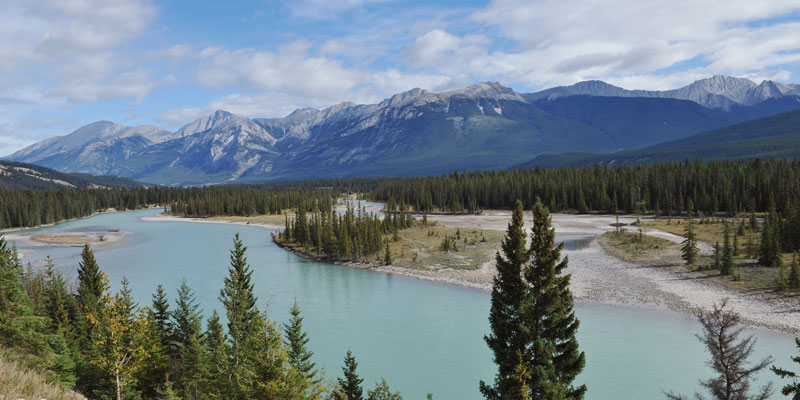Contaminant Fate and Transport in Integrated Fractured Rock Subsurface and Surface Water Systems
Principal Investigators - E.A. Sudicky & J.F. Sykes, University of Waterloo (2001-2004)

Challenge
Advanced methods such as mathematical modeling for groundwater and surface water systems have evolved independently, including the characterization and economic valuation of these systems. To some extent the separate methods have developed incompatibly. Consequently, for most watersheds very little is known about the sustainable capacity of the resource to provide for water needs and to receive the waste of its communities and associated industries. The lack of integrated information can lead to uncoordinated planning and policy, and unpredictable and undesirable environmental consequences that require costly future remediation or lead to irreparable damage to the resource.
This project was designed to develop physically-based modelling tools that treat surface and subsurface water flow in 3D, including contaminant fate and transport, within watersheds in a fully-integrated framework for application at multiple scales. Because the models are physically-based numerical models, they can be applied to watershed types ranging from those underlain by fractured rocks to those composed of unconsolidated granular deposits. This research was directed at policy and regulatory decision-makers to better understand the dynamics of surface water and fractured groundwater systems at the watershed scale to predict the effects of municipal, agricultural, industrial activities and climate change on water quality and quantity in these systems.
Project
As minimal scientific knowledge is available to describe the interaction of surface water and groundwater flow systems within watersheds in the crystalline rock setting of the Canadian Shield, the researchers designed and completed a 3D watershed model, HydroGeoSphere, incorporating surface and ground water flow and contaminant transport processes for this system. This model was applied to a number of watersheds, including those in the Portneuf area in Quebec. These rural watersheds experience nitrate contamination of groundwater from fertilizers. HydroGeoSphere was used to investigate and calibrate the parameters for groundwater and surface water flow in the basin for a spring to fall time period. Model output was compared to the observed continuous hydrologic record. The work provided a better understanding of model and physical parameters for integrated surface water/groundwater systems of watersheds in Canadian Shield settings.
The model was applied to watersheds in the Fraser Valley, B.C. HydroGeoSphere allowed for study at the watershed scale, to examine the cumulative effects of distributed withdrawals. The model was used to determine whether surface water impacts could be mitigated by preferential development of deeper, confined aquifers.
Another research project involved a continental-scale application of HydroGeoSphere that produced a 3D simulation of the surface and subsurface flow regimes for all of Canada. This simulation was driven by paleoclimate, specifically the climate-induced glaciation and deglaciation of the North American continent. The model also enhanced existing watershed modeling in the Grand River watershed in Ontario, accounting for seasonal and event-based transients integrating surface and subsurface flow regimes.
Outputs
- Development of an advanced 3-D watershed model, HydroGeoSphere.
- Development of data management tools.
- Creation of research collaborations.
Select Presentations:
The members of the research team presented their findings at many major national and international conferences, and organized special sessions at these meetings. Many of the former PhD students trained by the team members currently hold faculty positions at universities in Canada and the US. All of the team members are internationally recognized for their research contributions and are highly-cited authors and collectively have received numerous awards and honours, both nationally and internationally.
S. D. Normani, J. F. Sykes, E. A. Sudicky Y.-J. Park, 2005. Paleo-Evolution And Uncertainty Analysis of Regional Groundwater Flow In Discretely Fractured Crystalline Rock. ModelCare 2005, Fifth International Conference on Groundwater Modelling from Uncertainty to Decision Making, Scheveningen NL. 6 pages. June 2005.
J. F. Sykes, E. A. Sudicky, S. D. Normani, R. G. McLaren, M. R. Jensen, 2005 Long-Term Regional And Sub-Regional Scale Groundwater Flow Within An Irregularly Fractured Canadian Shield Setting. Canadian Nuclear Society Conference – Waste Management, Decommissioning and Environmental Restoration for Canada’s Nuclear Activities: Current Practices and Future Needs, Ottawa Ontario. 11 pages. May 8-11 2005.
Sudicky, E.A., Jones, J.P. and Brookfield, A.E., 2005. Quantifying Groundwater Contributions to Streamflow Generation: The Reliability of Tracer-based Hydrograph Separation Techniques, ModelCARE 2005, 5th International Conference on Calibration and Reliability in Groundwater Modelling, June 6-9, 2005, The Hague (Scheveningen) Netherlands (invited).
Normani, Stefano D., Sykes, Jon F. and Jyrkama, Mikko I., 2004. Can Contaminant Transport Be Simulated Assuming Steady-State Flow, GSA paper 68-14. Denver Co. November 7-10, 2004.
Jones, J.P., Brookfield, A.E. and Sudicky, E.A., 2004. Quantifying groundwater contributions to streamflow generation: The reliability of tracer-based hydrograph separation techniques, AGU/CGU Spring Meeting, Montreal, Quebec, May, 2004.
Select Publications
Park, Y.-J. Sudicky, E.A., Panday, S., Sykes, J.F. and Guvanasen, V., 2008.Application of implicit sub-time stepping to simulate flow and transport in fractured porous media, Adv. Water Resour., doi:10.1016/j.advwatres.2008.04.002, 9pp.
Jones, J. P., E. A. Sudicky, A. E. Brookfield, and Y.-J. Park , 2006. An assessment of the tracer-based approach to quantify groundwater contributions to streamflow, Water Resour. Res., 42, W02407, doi:10.1029/2005WR004130, 15pp.
Jones, J. P., E. A. Sudicky, A. E. Brookfield, and Y.-J. Park , 2006. An assessment of the tracer-based approach to quantify groundwater contributions to streamflow, Water Resour. Res., 42, W02407, doi:10.1029/2005WR004130, 15pp.
Park, Y.-J., Sudicky, E.A., McLaren, R.G. and Sykes, J.F., 2004. Analysis of hydraulic and tracer response tests within moderately fractured rock based on a transition probability geostatistical approach, Water Resour. Res., Vol. 40, W12404, doi:10.1029/2004WR003188, 14pp.
Jianting Zhu and Jonathan F. Sykes, 2004. Simple screening models of NAPL dissolution in the subsurface, Journal of Contaminant Hydrology, Volume 72, Issues 1-4, 245-258.
Outcomes
- Through the integration of groundwater models and biosphere models, the research provided an improved understanding of the link between subsurface waste practices and their impact on human health.
- The advanced models and data management tools developed through this research have gained world-wide attention and are being used by numerous university and government-based scientists as well as the private sector.
- Creation of collaboration with HydroGeoLogic (HGL), Inc., a high-tech environmental engineering/hydrogeology firm headquartered in Herndon, Virginia, that established a satellite office in the City of Waterloo, and with the US Bureau of Reclamation (USBOR).
- Advanced understanding of the physical and chemical stability of deep-seated subsurface flow systems in fractured crystalline rock for the safe storage of spent nuclear fuel.
- The HydroGeoSphere model was adopted by the USBOR and the California Water Department to study a variety of water-related issues within the Central Valley of California. The HydroGeoSphere model was used by an extensive European Union Framework 6 project linking researchers from 18 EU universities and research institutions to study the impacts of non-point-source contaminant inputs, including climate and land-use change, on surface water and groundwater quality and soil functioning within several key watersheds within Europe (e.g., River Rhine, Danube River).
- The research team was instrumental in establishing linkages with the US-based Consortium of Universities for the Advancement of Hydrologic Sciences, Inc. (CUASHI) and the proposed National Center for Hydrologic Synthesis (NCHS) at UC Berkeley. They also established a collaborative relationship with researchers at Seoul National University (SNU) and the Korean Institute of Geoscience and Mineral Exploration (KIGAM), and the HYMAP group in Quebec.




